I recently bought this small set of photos, showing men and women at work on Hong Kong's streets.
What: I can recognise the sugar cane for sale on the left, but what sort of snack is that on the right?
Who: The hawker is an older man, assisted by a young girl who is probably his daughter or granddaughter. There must have been another adult nearby, in charge of the sugar cane. (It can't have been the young girl as even when she stood up her shoulder wouldn't reach the pole!)
Both sets of tables and baskets have kept their shoulder poles attached, as though ready for a quick getaway, and the man and girl are looking in different directions. I wonder if they're selling without a license, and keeping a lookout for policemen?
"Hawking Offences" was by far the largest category of offences dealt with by Hong Kong's policemen in the early 20th century. The Police report for 1930 shows that over 45% of the total cases reported that year, 11,282 out of 24,931, were Hawking Offences.
Where: It's a sloping road with a stone retaining wall in the background that has a distinctive recess and pipe. Many of the old retaining walls still exist, so please let us know if you recognise it.
Who: Another man and his shoulder pole, though he looks to be making a delivery rather than selling as a hawker. His clothes have seen better days, with rips in his trousers. But maybe he isn't doing so badly as he is one of the few men in these scenes wearing shoes, and the only one I can see who is wearing socks.
Where: These first two photos aren't the sharpest, so we can't see all the details. But the pillar clearly shows "Ladies Tailor Hats Maker", and the sign resting against the pillar is also clear to see. Please leave a comment if you recognise them.
Who: The man sitting in the foreground is a rickshaw puller, waiting for his next customer. A colleague dressed in similar hat and clothes stands beyond him, leaning on the rickshaw. Both their hats have numbers painted on them, which I guessed would match the number of their rickshaws.
Unfortunately a rickshaw's number was displayed on the back of the vehicle, so it is out of sight. There is a number shown on the seat cushion, but ... it doesn't match either of the hats, so perhaps there's no connection after all.
On the right stand two more men. They wear similar, light-coloured clothes, so they're likely rickshaw pullers too. They wear different shaped hats though. That may be a sign they came from a different part of China, as Chi Ming Fung explains in his book Reluctant Heroes: Rickshaw Pullers in Hong Kong and Canton, 1874-1954:
An essayist, writing in 1937, spoke of an observable phenomenon of his own lifetime: rickshaw pullers of different hometown origins wore hats of different styles. As a rule of thumb, the bamboo hats of Hoklo natives were cone-shaped with sharp points at the top. Those with hats that were rounded and flat at the top were Chiuchow (Kung Sheung Daily News June 14, 1937).
Where: Another blank. The rickshaw rank I've seen most often is the one on Connaught Road, in front of St George's Building. But that doesn't match the background of this photo.
Instead we're looking at a wall with railings on top, with what looks to be a column or possibly a statue's plinth beyond. Does it ring any bells?
When: The seller dated these photos to "c.1930". I don't see anything to contradict that, e.g. the rickshaw's wheels suggest the photo was taken before WW2, as they're the type with wooden spokes, looking like wooden cartwheels. If I look down the list of photos tagged 'rickshaw' here on Gwulo, the earlier photos all show wheels like this. Then in the later, post-war photos, the rickshaws' wheels all look like bicycle wheels, using metal spokes.
A couple of Harrison Forman's photos, taken in 1940-41, capture the transition. Here's one, with the old style wooden wheel in front, and the new metal-spoked version following on behind.
What: Here's a different style of shoulder pole, and a mysterious load. At first I thought it was a table being carried upside down, but if those are table legs they are very close together. Surely the table would fall over?
So now I think it is being carried the right way up. The "legs", are angled inwards so perhaps the tray in the centre somehow attaches on top of them?
Looking closer at that tray, it contains a couple of metal dishes, and a chicken enjoying the ride. Is this some sort of cooking apparatus? Though one chicken wouldn't feed many customers, so the 'hawkers selling food' explanation doesn't sound quite right.
There are some Chinese characters on the base of the frame. Do they give any clues what it was used for?
Where: This is a much sharper photo than the previous ones, but unfortunately the background is out of focus so we can't read either of the signs on the wall. If you can see anything that identifies the location, please let us know.
That covers all the men in the set. Next time we'll take a look at the three photos of women at work.
Trivia:
The photos in this set look like the commercially produced photos that were sold to tourists who'd paste them into their photo album. The eBay seller probably acquired the album, removed all the photos, then sold them individually or in small lots like this one.
Further reading:
- See more photos on Gwulo tagged:
- There are lots more photos and their stories in my Old Hong Kong Photos and The Tales They Tell series of books
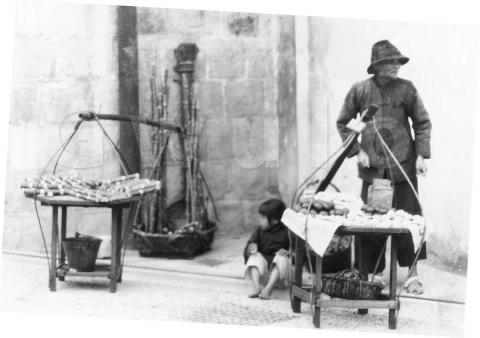

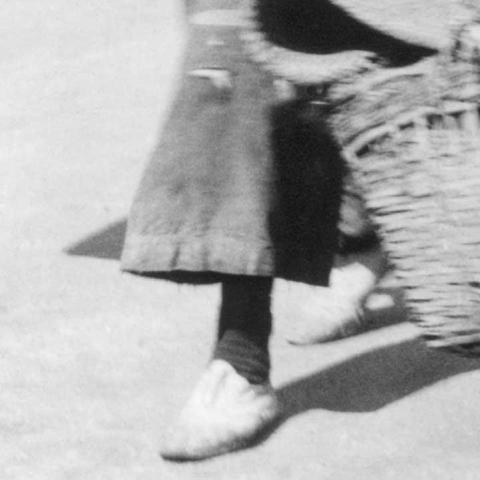
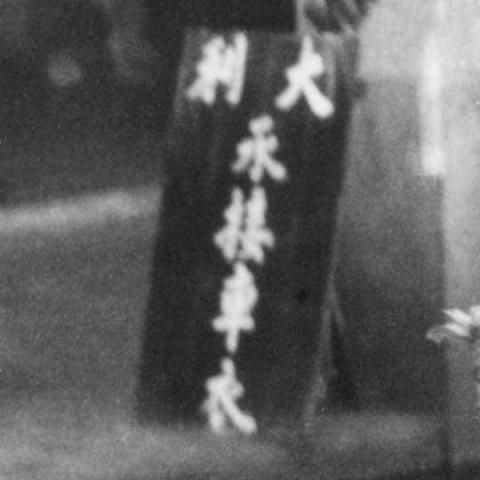

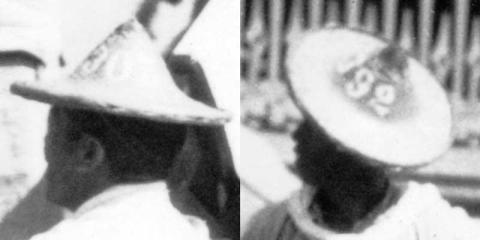
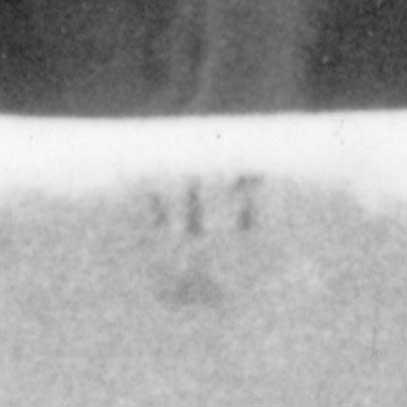
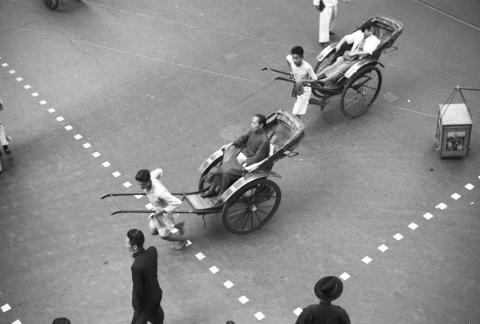

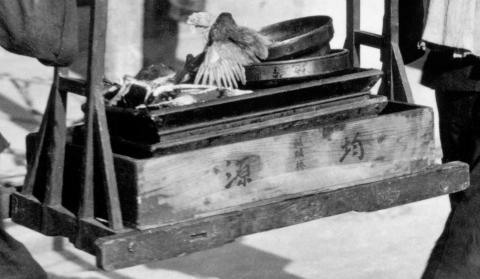

Comments
Re: sign on the ground
Hi David,
The sign on the ground has the name of the business, (大利) and what business it is in (offering machine stitching service if translating literally). Some production service of amending clothings or tailoring.
T
Old Photos
1) 1st photo - looks like darker tangerines on the left of the tray and lighter peeled tangerines on the right
2) 2nd photo - street corner laundry shop with its signage on the front of both columns & the TAILOR signage on the side of the second column.
3) the last photo - The big tray with the words 均源 (business name) & 鵝頸橋 (location) likely fit on top of the slightly inward-angled legs to make a table. The smaller rectangular trays that the chicken rested on looked like the kind for holding a whole roasted suckling pig. One of the round metal trays had the word 地 on it; these round trays probably were used as food covers rather than as food holders as the words were inverted the way it was in the photo.
Rickshaw Rank
I think the rickshaw rank is the one outside the main entrance to the naval yard buildings.
re: Men at work in the 1930s
Thanks for the feedback and extra information.
Hawkers - Tangerines do look like the explanation. I also heard from Tom who thinks the jar might hold water chestnuts.
Carrying baskets - I'll keep an eye out for the slogans on the laundry shop pillar in other photos, as they are quite distinctive.
Rickshaw pullers - Thanks to Moddsey, and to Axel via email, for identifying the rickshaw rank's location. I'd never have thought of that one.
Upside-down table - Another surprise! Both T and tkjho made the connection with roast suckling pigs, and T reminded us of this photo:
Roast pig
When I saw the photo above, I remembered taking a photo of a roast pig in 2011. It was on a street in the Jordan area on the occasion of the opening of a store. So still on the streets of Hong Kong, certainly the way of transport is different.
Re: Roasted Pig delivery
Hi Klaus,
These days the BBQ shops would hire cargo vans for delivery if they do not have one themselves. However some of the shops still use the traditional wooden trays to present their roasted pigs of all sizes.
T